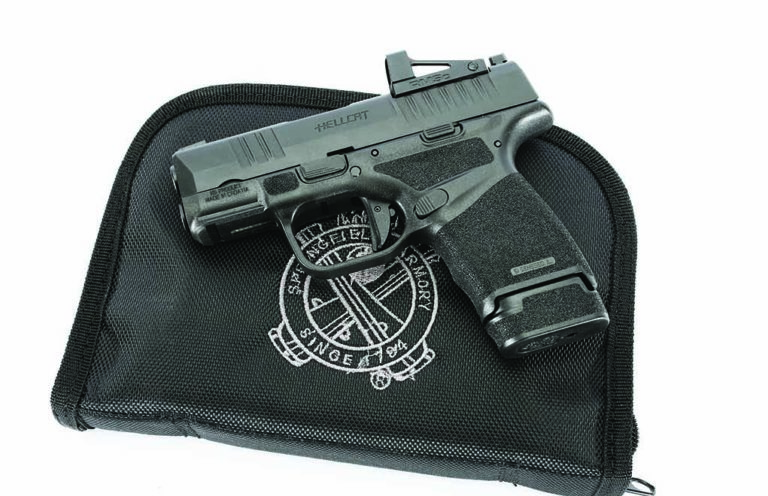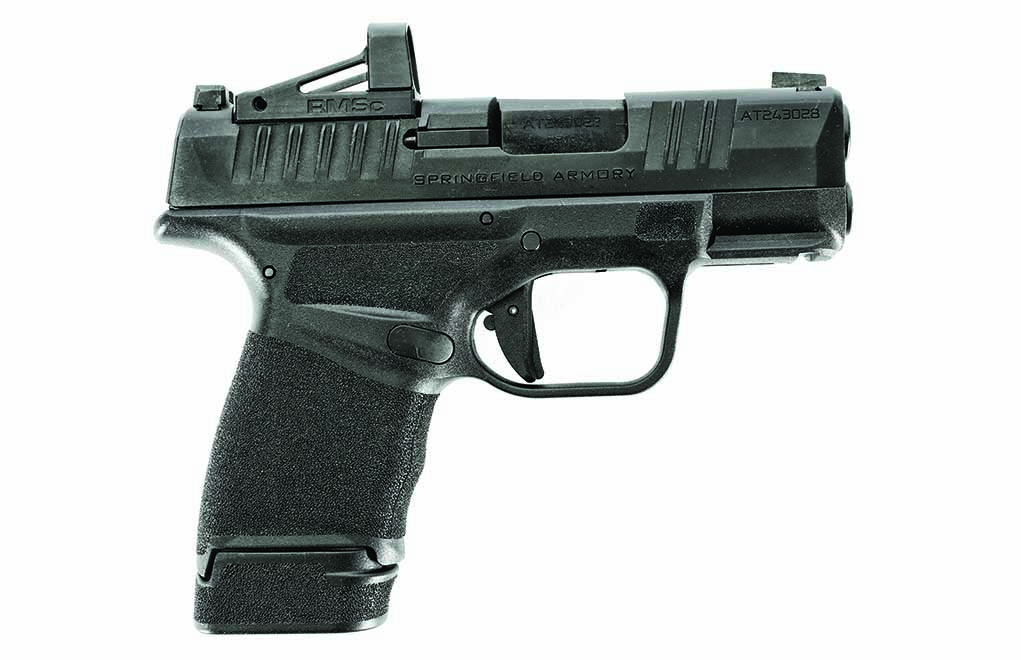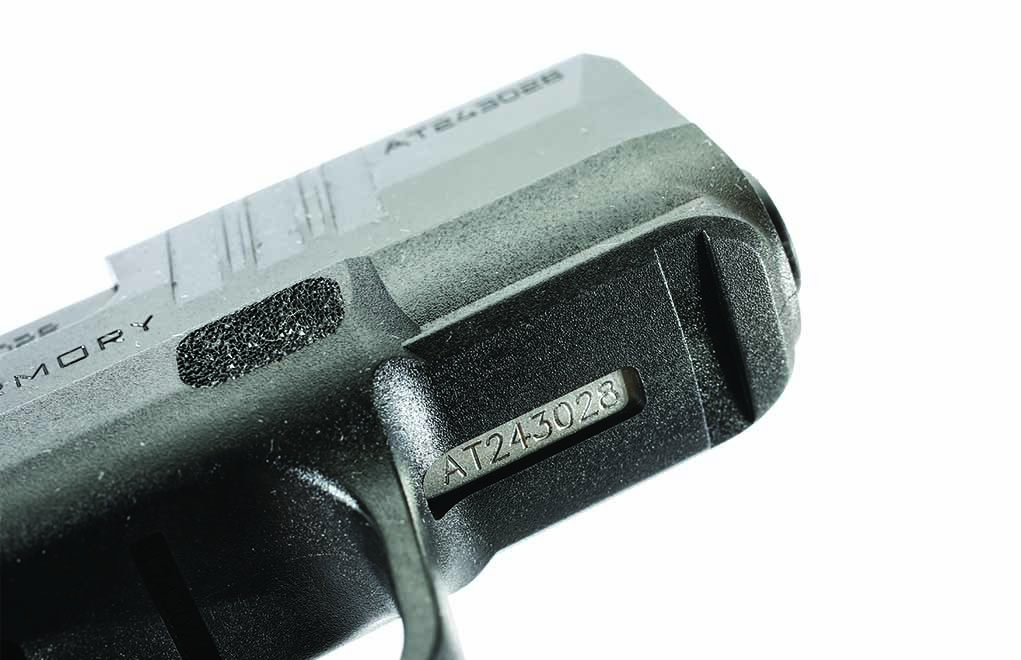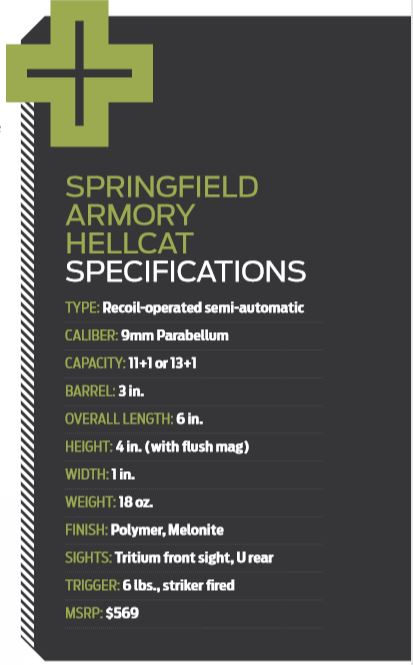
The 21st-Century concealed carry pistol has arrived. Shake hands with Springfield Armory Hellcat.
To steal a line from the TV show, Travelers, “Welcome to the 21st.”
How The Springfield Hellcat Advances The Compact 9mm:
- Advanced grip texturing makes the pistol more manageable and quicker on which to get a purchase.
- Reversible mag catch makes pistol lefty friendly.
- Baseplate extender gives your pinky real estate.
- Milled slide gives you the option of hassle-free red-dot addition.
It wasn’t that long ago that the latest breakthrough in EDC gear was 9mm pistols that were not much larger than .380s used to be. Oh, back in the old days (not much good about some of them), we all loved the size of .380 compact pistols while being just a tad anxious about carrying “only” a .380.
Then, within the lifetime of the newest EDC pistol-packers among us, 9mm pistols shrank down to the size the bigger .380s had been … and then shrank again … until the compact 9mm pistol was no larger than a compact .380 had been.
Read More Springfield Reviews
But, as with all things, there was a price: capacity. At six shots per, it hardly mattered if what you were carrying was a snub-nosed revolver, a .380 or a 9mm Parabellum.
Not that the pistol makers didn’t try. The smallest 9mm Glocks, for example, held 10 rounds in a magazine in the G26, but the grip was like trying to hold the stub of a 2×4. The S&W 6900 series pistols weren’t a lot better: They held 12 rounds but were only a bit more hand-friendly to shoot.

All that changed with the Sig 365, but that company was not the only one working on the problem. Sig just happened to be first. Just.
The Springfield Hellcat is what the G26 and the 6900 series could have been but weren’t: a hand-friendly, medium-capacity, 9mm compact pistol.
Getting A Grip On The Springfield Hellcat
The heart of the Springfield Hellcat is a polymer frame with an interesting nonslip texture Springfield calls an “adaptive grip texture.” It’s a mix of flat-topped pyramids, with sharper ones in between and lower than the flat tops. As a result, when your hand has to slide, it can slide over the flat tops. When you press down, your skin goes down between the flat tops to the sharper ones. Plus, your skin now has to slide over the edges of the flat pyramid tops.
Consequently, you get the best of both worlds: Slide when you need to, and stick when you must. This is the sort of thing a polymer molded product can do that a metal one can’t (well, you could, but the machining would be prohibitive, even in the modern CNC era).

recesses for the baseplate and also so that you can get a hold of the magazine, should you need to “encourage” its removal.
This texture is on the lower part of the frame, where you’d be grasping it, plus two spots—one on each side, forward of the trigger. That’s where your trigger finger can find a safe haven when it’s supposed to be outside the trigger guard.
Reversible Mag Catch: The New Normal
The magazine catch is reversible. Yes, yes, we all want an ambidextrous magazine catch—but really? Do we? I know that I don’t.
I’ve spent 50-plus years teaching myself that the mag button is on the left side. I don’t need an ambidextrous button, but if I’m dedicating a pistol as a backup—a secondary pistol for left-handed use—a right-side button might be nice. This way, I have a choice. New shooters who are left-handed get a choice as well. If you’re going to spend time with other pistols, you might want to leave it on the left side. If, however, you’re going to only go with pistols that can be swapped, then switch it over, get used to the new normal, and get on with your life.
There’s an accessory rail out on the front of the frame. Yes, it has only one cross slot, but how many do you really need? This is an EDC pistol, so you’re going to spend lots of time and effort keeping it concealed. A honkin’-big light or laser is not what you need. However, a very compact light to go with your very compact pistol might be just the ticket. So, Springfield gives you a choice. The accessory rail is also the location of the serial number—in a plate in a recess in the middle of the rail.
The Springfield Hellcat's Extension
The frame is recessed on the sides at the magazine well to accommodate the magazine baseplate. This also gives you a place to weasel onto the magazine, should it prove reluctant to fall out on demand. The standard magazine holds 11 rounds and has a flush baseplate.

You can also have a finger-groove extended baseplate—what Springfield calls the “pinky extension”—but it doesn’t add capacity. Then, there’s an extended magazine that holds 13 rounds, and the baseplate is molded to the contours of the frame. Basically, it looks like it’s a longer-framed Hellcat, and, if you have large hands, it makes it easier to hold onto.
The baseplates are all molded to fill the side gaps, and you can get a good grip on any of them, should the need arise.
The trigger is the now-standard one we see on striker-fired pistols: There’s a safety blade in the middle that keeps the trigger from moving until your finger has moved the blade. The trigger, itself, is flat, and the trigger is vertical at the point in its pivot where it releases the striker.
The trigger pull is nice and clean, with an obvious take-up and then pressure until the striker falls a small amount (mechanically unavoidable) after the striker falls. The internals are nickel-boron coated for a slick, low-friction surface, and it will be easy to clean once you get in there.
Don’t Conceal Your Curiosity: Dive Into CCW Insights
- Best Gun for Concealed Carry [Field Tested]
- Concealed Carry Handguns for Women
- Best Conceal Carry Upgrades – Must-Have Concealed Carry Accessories
- Best Concealed Carry Insurance – CCW Insurance Options
- Best Optic for Concealed Carry – Results from a Groundbreaking Study
The Springfield Hellcat's Upper Half
Things get even more interesting in the upper half.

First of all, the barrel is only 3 inches long, and the slide is machined to match that. As a result, you have a very compact pistol that’s good for concealed carry. The barrel locks up in the ejection port—as all pistols now do, except for the legacy designs that can’t.
There’s an opening at the rear of the hood that acts as a loaded chamber indicator. You simply look to see if there’s the rim of a cartridge or not—no extra parts, nothing to go awry. The barrel is hammer-forged, and the barrel and slide are given a Melonite treatment. This is a surface treatment that produces a very hard, very corrosion-resistant surface, which is then blackened. This, too, is the current state of the art and a common detail on all things Springfield.
The ejection port is matched with a robust extractor to make sure any and all cartridges, fired or not, are pulled out and tossed away when the slide cycles.
The slide, itself, is also interesting. First, there are cocking serrations fore and aft. The ones out front aren’t extensive, and they don’t appear to be designed as holster-shredding extras. If you work the slide by grasping it forward, they will help. On the rear, the cocking serrations on one model of the Hellcat are machined on both sides and continue over the top to match the other side. So, if you’re in the habit of wrapping your hand over the rear of the slide to work it, you get cocking serrations on three surfaces, not just two.

The other model has the top plate as a removable one for mounting a red-dot sight. That’s the one I received. The removable plate means it’s a no-gunsmithing operation to install or remove the red-dot sight (that’s good for you and bad for gunsmiths).

The rear of the slide has a cover plate, holding the striker parts in the slide. The sights are a tritium front with a U-shaped rear notch and ringed with a white outline.
The Springfield Hellcat comes with a spare, added-capacity magazine (the magazines are all-steel), lock and zippered case for storage. The Hellcat that was sent to me came with an RMSc red-dot sight already mounted and zeroed.
Observations
Shooting was the uneventful experience I expected it to be. The Springrield Hellcat ate all the ammo types I brought. It shot them to the sights. It never failed to fling the empties away, and it locked open every time I fired the last round.

Recoil was not mild—not that I’d have expected it to be from a 9mm pistol that weighs only 18 ounces. However, it was not objectionable; nor had I expected it to be. The ergonomic contours of the Hellcat grip evenly distribute recoil, and the overall effect is not sharp jabs or corners. Rather, it’s just an ultra-compact 9mm letting you know you’ve touched off a defensive round.
EDC 9mm
The current hot ticket for an EDC (everyday carry) setup is a compact 9mm pistol with a red-dot sight on it. For cutting-edge shooters, that means carry in an AIWB (appendix/inside the waistband) holster. Me? I’ll pass on the appendix position. I’m not comfortable carrying there, because even the short barrel and slide of the Hellcat cause binding; and, when I sit down, the Hellcat (or any pistol) wants to pop up out of the holster. For me, AIWB is a non-starter.
Instead, I’d be packing the Hellcat at the 4 o’clock or the FBI position. And there, it would be very comfortable, indeed.
The current accuracy standard is not that any pistol or revolver with a barrel fewer than 3½ inches doesn’t get fired at 25 yards. Fifteen yards is the standard for the compacts. I’m not necessarily in agreement, but “orders is orders,” so that’s what I do. And the Hellcat certainly did its part.

Part of that is the red-dot sight. Once you get over the apparent movement, you can shoot. The first time someone shoots with a red-dot sight, they mention the movement.
‘Geez; it’s shaking all over the place!’

Well, that happened before, but you couldn’t see it—and you shot well then. Now, you can see it … and you can shoot even better.
I’d never call something as compact as the Hellcat a “bull’s-eye gun,” but it shot a lot better than you’d expect an ultra-compact 9mm pistol to shoot.
And the best part of all this? The price. The Hellcat’s MSRP is $569, but we all know that gun shops will be stuffing them into their display counters (and quickly pulling them out for sale) at less than that.
Clearly, Springfield has a winner on its hands with the Hellcat.
The article originally appeared in the Janurary 2020 issue of Gun Digest the Magazine.
For more information on the Springfield Hellcat, please visit springfield-armory.com.
More Springfield Reviews:
- Springfield XDS
- Springfield Saint
- Sprinfield XDE
- Springfield XDM
- Springfield 911
- Springfield Saint Victor
- Springfield Saint Edge

Next Step: Get your FREE Printable Target Pack
Enhance your shooting precision with our 62 MOA Targets, perfect for rifles and handguns. Crafted in collaboration with Storm Tactical for accuracy and versatility.
Subscribe to the Gun Digest email newsletter and get your downloadable target pack sent straight to your inbox. Stay updated with the latest firearms info in the industry.

![Best Concealed Carry Guns In 2025 [Field Tested] Wilson Combat EDC X9S 1](https://gundigest.com/wp-content/uploads/Wilson-Combat-EDC-X9S-1-324x160.jpg)


![Best 9mm Carbine: Affordable PCCs [Tested] Ruger Carbine Shooting](https://gundigest.com/wp-content/uploads/Ruger-Carbine-Shooting-100x70.jpg)
![Best AR-15: Top Options Available Today [Field Tested] Harrington and Richardson PSA XM177E2 feature](https://gundigest.com/wp-content/uploads/Harrington-and-Richardson-PSA-XM177E2-feature-100x70.jpg)
